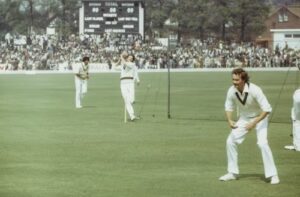Evolution of Formats
Cricket has evolved over the years, leading to the development of various formats that cater to different styles of play and audience preferences. Here’s a brief overview of the evolution of cricket formats:
Test Cricket: Test cricket is the oldest and traditional format of the game. It originated in the 19th century and is played over five days. Each team gets two innings to bat and two innings to bowl, and the team that scores the most runs over both innings wins. Test matches are known for their strategic and patient gameplay, often favoring bowlers and allowing for in-depth battles between batsmen and bowlers.
One Day International (ODI) Cricket: ODI cricket was introduced in the 1970s as a response to the need for shorter and more spectator-friendly matches. Each team gets 50 overs to bat and 50 overs to bowl. ODI cricket brought a faster pace to the game and introduced limited-overs strategies, with an emphasis on both batting and bowling performances.
List A Cricket: List A cricket refers to limited-overs matches played at a domestic level. These matches follow the ODI format and are typically played over 40 or 50 overs. List A matches provide a platform for domestic players to showcase their skills and compete for selection at the international level.
Twenty20 (T20) Cricket: T20 cricket revolutionized the game when it was introduced in the mid-2000s. Each team gets 20 overs to bat and 20 overs to bowl. T20 cricket is known for its high-scoring matches, aggressive batting, and innovative shots. The format has gained immense popularity due to its shorter duration, making it more appealing to a wider audience.
The Hundred: The Hundred is a relatively new format introduced in 2021 in England. Matches in The Hundred consist of 100 balls per innings, with each bowler allowed to bowl a maximum of 20 balls. The format aims to attract new audiences to cricket and provide a fast-paced and accessible version of the game.
These formats cater to different playing styles, skill sets, and preferences. The evolution of cricket formats has not only brought variety to the game but has also expanded its reach and appeal to different demographics around the world.


Evolution of Cricket Ball
The evolution of the cricket ball has undergone several changes over the centuries, with advancements in materials and manufacturing techniques playing a significant role. Here’s a brief overview of the evolution of the cricket ball:
Early Cricket Balls: In the early days of cricket, the ball was often made from a leather case filled with materials such as cork or wool. The shape and size of these early balls varied considerably, leading to inconsistencies in the game.
Hand-Stitched Leather Balls: As the game became more organized, cricket balls began to be made with hand-stitched leather. These leather balls were filled with cork shavings or other materials to give them weight and shape.
Introduction of Seam and Shape: The development of a prominent seam on the ball allowed bowlers to generate movement in the air and off the pitch. This marked a significant step in the evolution of bowling strategies, as bowlers could now use seam movement to deceive batsmen.
Duke and Kookaburra Balls: In international Test cricket, two main types of balls are used: the Duke ball in England and the Kookaburra ball in most other countries. The Duke ball is known for its ability to swing and seam, particularly in conducive conditions such as in England. The Kookaburra ball is used in countries with dryer climates and is known for its hardness and consistent behavior.
White and Pink Balls: With the introduction of limited-overs cricket, white cricket balls were developed to improve visibility under floodlights. Pink cricket balls were introduced for day-night Test matches, allowing for better visibility during evening sessions.
Technology and Manufacturing Advances: Modern cricket balls are manufactured using advanced techniques and materials to ensure consistency in shape, weight, and performance. The process of making cricket balls involves layers of cork and tightly wound string covered by leather, all of which contribute to the ball’s bounce and behavior.
Innovations and Research: Ongoing research and innovations aim to improve the durability, visibility, and performance of cricket balls. Manufacturers continually work on refining the construction of the ball to enhance its playability and maintain a balance between bat and ball.
The evolution of the cricket ball has played a crucial role in shaping the dynamics of the game, influencing batting, bowling, and fielding strategies. Advances in ball manufacturing and design have led to more consistent and exciting cricket matches across different formats and conditions.

Evolution of Cricket Bats
Cricket bats have undergone a remarkable transformation over centuries, reflecting the sport’s evolution and technological advancements. Initially, cricket bats were crafted from simple, rough-hewn willow or ash wood. The early designs featured a straightforward shape with a flat hitting surface. As the game evolved and players sought ways to enhance their performance, the design and construction of cricket bats saw significant modifications. Craftsmen began selecting willow varieties with optimal qualities for bats, refining the shape to maximize power and control.
Throughout the years, innovations in bat manufacturing techniques emerged, enabling the creation of more sophisticated and efficient designs. These advancements included steam pressing, which helped to contour the wood for better performance. Subsequently, the advent of industrialization allowed for precise shaping and improved balance, leading to the development of the iconic blade shape with a curved blade profile. Additionally, alterations in the weight distribution and handle design allowed players to wield the bat with enhanced agility and control, facilitating more powerful strokes.
In recent decades, technological advancements and research into materials science have further revolutionized cricket bat construction. Modern bats are designed using computer-aided modeling and cutting-edge manufacturing processes. Composite materials and reinforced carbon fibers are now incorporated into bat designs, enhancing strength without compromising on weight. These materials provide improved power transfer and shock absorption, ensuring bats are responsive and resilient. The handle design has evolved to dampen vibrations and offer players a better grip, promoting comfort and precision during play. The evolution of cricket bats continues as manufacturers experiment with new materials, optimizing design to meet the demands of the contemporary game while preserving the essence of this iconic sporting equipment.
Evolution of Cricket Grounds
Cricket grounds have experienced a fascinating transformation over the centuries, evolving from humble, natural fields to state-of-the-art, meticulously engineered venues that host international matches. Early in cricket’s history, matches were played on uneven, rough grounds, often resembling natural clearings or open spaces. As the popularity of the sport grew, the need for dedicated cricket venues became apparent. The evolution of cricket grounds can be traced back to the late 18th century when purpose-built pitches began to emerge. These early grounds were often basic, with minimal facilities and rudimentary markings, but they marked the first deliberate efforts to create spaces exclusively for the sport.
Over time, the understanding of the game’s requirements and the desire for fair play led to significant improvements in cricket ground design. In the 19th century, the introduction of standardized pitch dimensions and markings revolutionized the game. The pitch became the focal point, with precise measurements ensuring fairness for both batsmen and bowlers. Evolution in ground maintenance and preparation also became evident during this period, with grounds men increasingly employing methods to maintain a consistent and suitable playing surface. As cricket became more organized and competitive, the need for spectator comfort and safety became paramount, prompting the establishment of grandstands and pavilions, enhancing the overall match-watching experience.
The 20th century witnessed a revolution in the design and facilities of cricket grounds. With advancements in engineering and architecture, stadiums became larger, more accommodating, and architecturally ambitious. The Melbourne Cricket Ground (MCG), often regarded as one of the world’s premier cricket venues, showcased modern stadium infrastructure, setting a benchmark for the future. The iconic Lord’s Cricket Ground in London also underwent substantial redevelopment, embracing modern amenities while preserving its rich heritage. The evolution extended to the playing surface itself, as turf management techniques improved, leading to meticulously maintained pitches that offered consistent bounce and pace.
In the 21st century, cricket grounds have taken on a futuristic, technologically driven transformation. Cutting-edge design, incorporating climate control systems, retractable roofs, and advanced drainage facilities, ensure matches proceed uninterrupted in various weather conditions. The rise of floodlit cricket brought about the installation of high-quality lighting systems, enabling day-night matches. Furthermore, the integration of digital technologies, such as advanced scoreboards and immersive spectator experiences, has enhanced the overall ambiance and engagement within the stadiums.
Moreover, the sustainability and environmental impact of cricket grounds have become paramount concerns in recent years. Efforts to reduce the carbon footprint of stadiums are underway, with initiatives such as rainwater harvesting, solar energy utilization, and eco-friendly waste management systems. This sustainability focus aligns with the broader global push for environmentally conscious practices.
In conclusion, the evolution of cricket grounds is a testament to the sport’s growth, embracing advancements in engineering, technology, sustainability, and fan experience. From humble beginnings on natural fields to futuristic, eco-friendly, and technologically advanced venues, cricket grounds have evolved in tandem with the evolution of the sport itself. Each era has brought about new challenges and innovations, and the future promises even more exciting developments, ensuring that cricket grounds continue to adapt and transform to meet the ever-evolving needs and expectations of players and fans alike.
